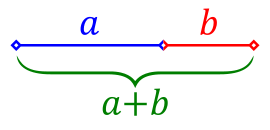Golden ratio
Two quantities are in golden ratio to one another if their ratio is the same as the ratio of their sum to the larger of the two quantities.
Expressed in mathematical formulas, the golden ratio of two segments a and b is
a/b = (a+b)/a or a/(a+b) = b/a.
The division ratio is dimensionsless and irrational, since:
φ = a/b = (a+b)/a = (1+√5)/2 ≈ 1,618...
Definition[edit | edit source]
It's said that two quantities a > b > 0 are in the golden ratio if
a/b = (a+b)/a
is satisfied
Criticism[edit | edit source]
Psychologists, starting with Gustav Fechner (1876), have proposed that humans could somehow recognize this ratio in all kinds of proportions and experience it as the most aesthetic proportion. Fechner's historical findings have however never conclusively been reproduced.[1][2] Some have even called the golden ratio "the biggest myth in design", saying it is only coincidental that aesthetic proportions sometimes resemble the golden ratio.[3] The proportions in humans that supposedly follow a golden ratio are often significantly different from the golden ratio.[4]
The golden ratio sometimes happens to be roughly similar to attractive proportions of the human body, such as a man's shoulder width to waist ratio,[5][6] however there is actually no evidence that people find golden ratios more attractive than other similar ratios, even though the golden ratio is often hyped to be the the most attractive ratio. Pommersheim et al. (2010) concluded that many alleged manifestations of in nature are fictitious,[7] except at the microsocopic or subatomic level, e.g. the magnetic resonance of spins in cobalt niobate crystals.[8] The entire concept is pretty much a myth.
References[edit | edit source]
- ↑ Livio, Mario (November 1, 2002). "The golden ratio and aesthetics". Plus Magazine. Retrieved November 26, 2018.
- ↑ Livio, Mario (2003) [2002]. The Golden Ratio: The Story of Phi, the World's Most Astonishing Number (First trade paperback ed.). New York City: Broadway Books. ISBN 978-0-7679-0816-0.
- ↑ https://www.fastcompany.com/3044877/the-golden-ratio-designs-biggest-myth
- ↑ Pheasant, Stephen (1998). Bodyspace. London: Taylor & Francis. ISBN 978-0-7484-0067-6.
- ↑ http://www.fitocracy.com/knowledge/a-brief-discussion-of-the-look-and-how-to-get-it/#:~:targetText=From%20there%2C%20the%20aim%20is,easily%20reduce%20your%20waist%20measurement.
- ↑ https://www.fitmole.org/perfect-male-body/
- ↑ Pommersheim, James E., Tim K. Marks, and Erica L. Flapan, eds. 2010. "Number Theory: A Lively Introduction with Proofs, Applications, and Stories". John Wiley and Sons: 82.
- ↑ http://www.eurekalert.org/pub_releases/2010-01/haog-grd010510.php
